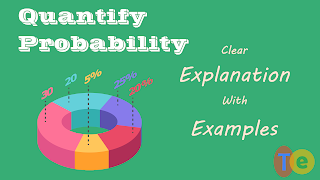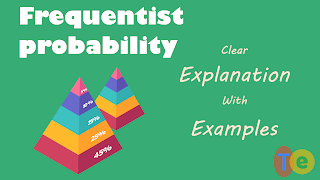Quantify probability
We finally come to the last foundation of statistics and probability. Quantify probability. If I said, my favorite team more likely to win the next game you probably feel that is a vague statement. I can do it better: my favorite team has an 80% chance to win the next game. How to come to that percentage? Well, you may think it must be very complex and even unachievable. Actually, there are only three principles when quantifying the probability.
Permutation and combination method: let us see an example. What is the probability of a rolling dice stop showing 6? There are 6 positions the dice may end up: 1 2 3 4 5 6. 6 is one of them. So that the chance of getting 6 is 1to 6. The key to quantifying probability using the permutation and combination method is finding all possible outcomes.
we can use permutation and combination to deal with a single random event but what if there are multi random events?
Sum method: when calculating the chance of a happens or b happens we can sum each probability together, given event A and event B won’t happen at the same time. Using the dice example, what is the probability of getting 6 or 5?. Since each event has a one-sixth chance of happening, the chance of getting 6 or 5 is one-sixth plus one-sixth.
Multiply method: when calculating the probability of independent events happens at the same time we can multiply each probability together. For example, what is the chance of while stacking in traffic and find out the car is running out of gas? for me it like one half times one-fifteenth. So it happens.
It worth mentioning here the difference between probability and odds. The odds are defined as the chance that the event will occur divided by the chance that the event will not occur while the probability is that an event will occur is the fraction of times you expect to see that event in many trials, and always range between 0 and 1. It is probably easier to understand by an example. Say the odds of my favorite team win the next game is they win to lose. The probability of my favorite team wins the next game is they win to (they win pulse lose).
In the real world the problems generally more complex and won’t be as simple as the example I just mentioned. But don’t worry below three methods will bring your probability quantifying skill to the next level.
First: Definition. As the name, sometimes we just assign a probability to an event. Think of toss a coin or dice, we just assign the chance of showing one side is ½ or ⅙. However, in the real world, there is no perfect coin or dice that all sides are externally the same. This method simplifies the world gives us a chance to build the model and study it.
Keynes said in his book [A Treatise on Probability]: “if there is no known reason for predicating of our subject one rather than another of several alternatives, then relatively to such knowledge the assertions of each of these alternatives have an equal probability” this classical definition is also know as The ‘principle of equal probability’.
Second: Frequency. The principle of equal probability is easy to apply but soon we find out that a lot of events don’t have equal probability, such as the defective percentage and gene mutation. Although we don’t know the percentage we do know that assume the chance is 50% and 50% makes no sense. To solve it frequency comes to the stage. It defines an event's probability as the limit of its relative frequency in many trials. For example, in order to find out someone’s shooting average, you can let him to shoot many times, as the sample growing bigger the shooting average will get more and more closer to the true percentage. This method is widely applied in many fields, I will discuss it in more detail in the next few episodes.
Third: Iteration: Will the frequency method can be used to find out all probabilities? I think you will agree that people’s shooting average will change given he had a lot of practice his shooting average probability gets improved. And sometimes we simply can’t repeat the event many times to find out the frequency, like forecasting tomorrow’s weather. But don’t worry we still have another tool to address this kind of problem. That is iteration. Iteration using the information we have to make a guess and then as more information emerges update the prediction accordingly. The most famous iteration is Bayes theorem.



Comments
Post a Comment